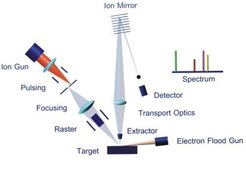How does TOF-SIMS work?
A pulse of ions bombards the specimen and sputters it. This produces a cloud of atoms and molecules among which are some ionized. The ionized particles of one polarity, atomic and molecular secondary ions, are accelerated into a reflectron type spectrometer. They travel two meters through a tube to arrive at an ion detection and counting system. However, because they all depart from the sample at the same time and were subject to the same accelerating voltage, the lighter ones arrive at the detection system before the heavier ones. The "Time-of-Flight" of an ion is proportional to the square root of its mass, so that all the different masses are separated during the flight and can be detected individually.

The next pulse of primary ions cannot start until the secondary ions of the first pulse have cleared the analyzer. Otherwise the slower heavy ions of the first pulse are overtaken by the faster light ions of the second pulse. However the time interval between consecutive pulses can be used for other activities, such as sputtering and charge neutralization.
Ion images are produced by scanning the primary beam over the sample surface and recording the number of ion as a function of the position. Since all ions are detected, the images of all the ions are detected in parallel. The bombarding ions also produce secondary electrons, which are detected to give secondary electron images. The spatial resolution of the images depends largely upon the diameter of the pulse of primary ions. The ion image resolution is better than 100 nm and the SEM image resolution better than 60 nm.
The sputtering of all the secondary ions should happen simultaneously so that the spectral resolution is not degraded. This requires the primary ion pulse to be short as possible. Pulsing is achieved by rapid deflection of the primary ion beam, and a device called a buncher is introduced into the primary ion column, compressing the pulse duration to less than 1 ns.
The TOF analyzer is vertically mounted. The extracted ions travel upwards to an ion mirror where they are reflected downwards to the detection system. This allows for easy compensation of the energy spread of the sputtered species (time focusing).
The detection system is a combination of a channel plate, scintillator and photomultiplier, combined with a very fast electronic counting system.
